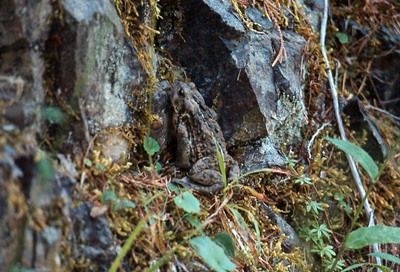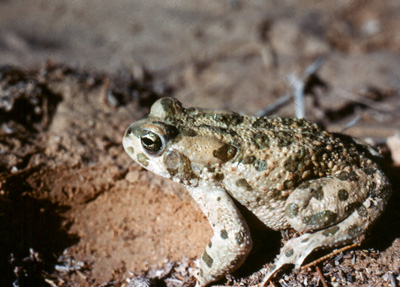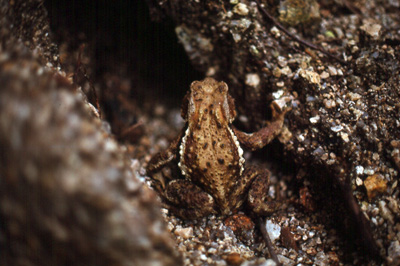GENETIC DIVERSITY
Genetic diversity is the way species adapt to change. The most important aspect of genetic diversity is that it can act as a buffer against the variability of environmental conditions, particularly in the medium and long term. Healthy environments can act as "shock absorbers" in the face of catastrophic disturbance. But what happens when organisms, such as trees, wheat, or other crops, are genetically selected by artificial means, through the intellectual isolation of linear-minded thinking, to satisfy short-term economic objectives of a supposedly independent variable within a dependent, interactive system?
Western toad from Oregon, USA.
Genetic manipulation of forest trees was born in the concept of short-term economic expediency. Of necessity, this process minimizes or discounts all long-term ecological ramifications to and within the forest as a whole, because tenable management practices for short-term profits must be based on predictable results. Genetic manipulation of "crop trees" is perceived by the timber industry as a partial panacea for the economic uncertainty of long-term financial expenditures in trying to control an unpredictable ecosystem through "management" (= attempted control or regulation).
Nevertheless, by manipulating the genetics of the trees, the function of ecological processes in the entire "managed" forest, be it an economic plantation or otherwise, is being altered by changing how the individual trees function. In turn, all other connected biological functions are altered. And we do not even know what these functions are, let alone what difference they will make in the long-term health of the ecosystem, though we can make some educated guesses.
Egyptian toad from the outskirts of Cairo.
A central thrust of modern agricultural technology has been to: (1) isolate such individual organisms as a particular species that possess one or more "desirable, economic characteristics;" (2) "enhance" the characteristics through artificial, selective breeding or through genetic engineering; (3) replicate the progeny on a massive scale; and (4) If trees, blanket the landscape with them in a gamble for increased short-term profits in the future. This type of plant is termed an "ideotype" (literally denoting an idea) because it is an ideal model of an industrialized, economic crop plant.
Any management, but particularly that focused on individual ideotypes, unavoidably changes other properties of the ecosystem in addition to productivity, the target of the change. Genetic diversity and its fundamental structural relationships—the architectural aspects of indigenous plant communities—are altered as well. Although numerous ecologists and occasional foresters have raised concerns about this for some time, these concerns have too often been viewed as grounded in unproven criticism that has little or nothing to do with competitive, industrial, economic "necessity."
Japanese toad from the island of Honshu.
In spite of that, by manipulating the genetics of plants, and now animals as well, the function of ecological processes in the entire ecosystem, such as a "managed" forest, be it an economic plantation or otherwise, is being altered by changing how the individual trees function. In turn, all other connected biophysical functions are altered. And we do not even know what most of these functions are, let alone what difference they will make in the long-term health of the ecosystem, though we can make some educated guesses.
Quite to the contrary, system-level properties are likely to play a pivotal role in the health of the ecosystem, and healthy, sustainable ecosystems provide values that are no less real because they cannot be traded in the marketplace. In this sense, every ecosystem can be likened to a numbered Swiss bank account that has a complete denomination of its own particular currency. You do not have to see the currency in order to get the correct change. If there is a virtually unlimited amount of money in the bank in all denominations (1, 5, 10, 25, 50, and 100 in both coins and bills), then any amount chosen can be received because the collective of the denominations can be translated into the exact amount requested.
This ecosystem currency (called "stored genetic variability") is unseen, as is the currency in the bank. In addition, the genetic variability in an ecosystem (the possible genetic combinations) is potentially unlimited over time. This means that the living components of the ecosystem can, within limits, adapt genetically to natural climatic changes, as well as those exacerbated by the human-caused greenhouse effect, the loss of atmospheric ozone, increasing air pollution, and so on. When genetic variability (the sum total of all denominations in the bank) is withdrawn from the ecosystem's genetic account through such things as selective genetic manipulation for short-term economic gains, the ability of the system to adapt to changing conditions-something it must continually do in order to survive-becomes artificially limited.
It is necessary here to reiterate that the past function of an ecosystem determines its present structure, and its present structure determines its potential future function. This means that structure is defined by composition, and function is determined by structure! Further, composition, structure, and function are based on genetic flexibility, genetic plasticity—an organism's inherent ability to adapt to changing conditions. Thus, as we humans alter the genetic composition of a species, so we alter its function in time. In this way, composition, genetic plasticity, structure, and function meld to create and maintain ecological processes both in time and across space, and it is the health of the processes that in the end creates an ecosystem as we know it, including genetic stepping-stones.
As species come and go, they enrich the world with their presence, as illustrated with insect pests. Having considered that point, it is time to contemplate the genetics of place, that is, local populations adapted to specific habitats—genetic stepping-stones. Their importance lies in our understanding that as we fragment the landscape in which we live through such things as urban sprawl, clear-cut logging, or dams in rivers we are putting our fellow planetary travelers at risk, often without even realizing it.
When we fragment landscapes, both plants and animals become vulnerable to "secret extinctions"—the loss of locally adapted populations, such as those of trees that have evolved over centuries and millennia. Such a loss can be more or less permanent and may inexorably alter the habitat because other populations of the same species might prove unable to reoccupy the habitat or might not even be able to reach it due to major changes in the environment.
As working example, let's consider the genetics of place with sugar maples, which range from sea level up to about 2,500 feet in elevation in New England. Depending on the elevation of their habitat, populations of sugar maples differ in a number of physiological characteristics. Those at high elevations can photosynthesize much faster than populations at middle elevations. In addition, the structure of their leaves is quite different.
Leaves of sugar maples growing at high elevations are thin. That is, for the same area of a leaf, the weight of the leaf is lowest at the high elevations and highest at the middle elevations, suggesting that sugar maples at high elevations produce cheap, throwaway leaves, much as some Mediterranean rock roses produce cheap, throwaway petals, that appear one day, stay wrinkled, and are gone before dawn the next.
Trees can produce large, thin leaves at far less cost in energy than they can thick leaves. Despite this low investment in leaf tissue, the trees' rate of photosynthesis is very high. Consequently, it stands to reason that such characteristics of low-energy, throwaway leaves coupled with high rates of photosynthesis are best adapted to the short growing seasons of high elevations. Indeed, leaf-out occurs ten days later at high elevations than at middle elevations and leaf-drop is ten days earlier—a difference of nearly three weeks in the growing season.
Because sugar maples shed their leaves each autumn and produce new ones each spring, the length of the growing season is critical to the type of leaves they produce. High-elevation sugar maples are right on the border of conditions to which the maples are suited, and the short growing season exerts a tremendous pressure in selecting for individual trees that can produce cheap, rapidly deployed, throwaway leaves that photosynthesize quickly.
Suppose a population of sugar maples was removed from the top 350 feet of its elevational range. Could it be replaced by sugar maples from middle elevations? You could physically transplant them, but they most likely would not survive because they lack the local genetics of place. Without the local adaptations necessary to survive at the top of the species' elevational range, sugar maples simply would not be part of the plant community. If the high-elevation population becomes extinct, its former environment would be less diverse, not only by one species of tree but also by all the extant visible and invisible, aboveground and belowground, interdependent species, processes, and feedback loops.1
When locally adapted, interactive, aboveground-belowground communities of plants and animals disappear, they cannot be replaced overnight—if ever. Nor can they be replaced through the myth of "management," a concept through which we give ourselves a false sense of security and power over Nature. In any case, this scenario is further compounded by functional diversity, a concept that both poorly understood and often ignored when it seems to interfere with economic objectives.
ENDNOTES
by
Chris Maser




©Chris Maser 2009. All rights reserved.